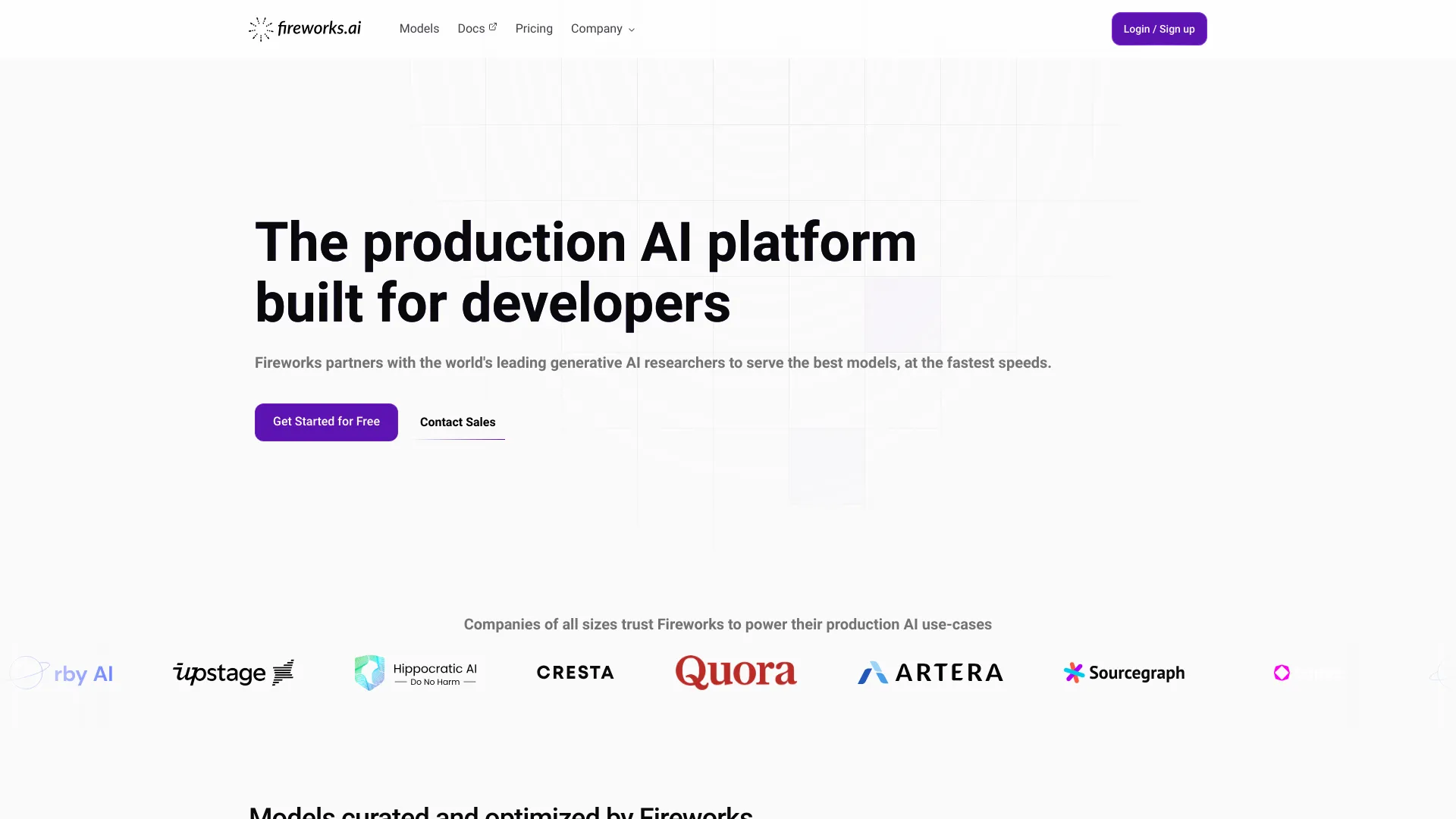- Home
- AI Image Generator
- Fireworks AI

Fireworks AI
Open Website-
Tool Introduction:Fastest gen‑AI inference for open‑source LLMs; fine‑tune, deploy free.
-
Inclusion Date:Oct 28, 2025
-
Social Media & Email:
Tool Information
What is Fireworks AI
Fireworks AI is a high-performance inference platform for generative AI. It serves state-of-the-art open-source large language models and image models with ultra-low latency, enabling production apps that feel instant. Developers can bring their own checkpoints, fine-tune models, and deploy to scalable endpoints at no additional platform cost. With flexible model APIs, customization options, and building blocks for compound AI systems, Fireworks AI streamlines the path from prototype to reliable, cost-efficient deployment.
Fireworks AI Main Features
- Ultra-fast inference: Low latency and high throughput for LLMs and image models, with token streaming and efficient batching to keep interactions responsive.
- Rich model catalog: Access leading open-source LLMs and image generators, or run your own checkpoints for full control.
- OpenAI-compatible APIs: Simple REST endpoints and familiar schemas make it easy to migrate or integrate with existing apps in Python, JavaScript, and more.
- Customization and fine-tuning: Train adapters or fine-tuned variants on your data, then deploy them without additional platform fees.
- Scalable deployments: Auto-scaling, versioning, and configurable endpoints support production reliability and traffic spikes.
- Compound AI building blocks: Tools for routing, RAG-style orchestration, tool/function calling, and structured outputs to compose multi-step systems.
- Observability and evaluation: Logs, latency metrics, usage tracking, and evaluation hooks to monitor quality and optimize cost.
- Security controls: API keys, project-level permissions, and governance features to help protect data and manage access.
Who Should Use Fireworks AI
Fireworks AI suits software teams building production-grade generative AI: startups seeking quick time-to-market, enterprises needing low-latency inference at scale, ML engineers and MLOps teams hosting and customizing open-source models, data scientists iterating on fine-tunes, and product teams creating chat assistants, content pipelines, code helpers, or image generation workflows.
How to Use Fireworks AI
- Create an account and generate an API key in the dashboard.
- Select a hosted model from the catalog or upload your own checkpoint.
- Call the chat/completions or image API with your key; enable streaming and set parameters (temperature, max tokens, guidance).
- Prepare a dataset and run a fine-tune or adapter training job; review evals and version the result.
- Deploy your chosen model to a production endpoint and configure scaling and rate limits.
- Integrate into your app via SDKs or an OpenAI-compatible client; add RAG or tool-calling if needed.
- Monitor logs, latency, and cost, then iterate on prompts, routing, or fine-tunes.
Fireworks AI Industry Use Cases
E-commerce teams deploy low-latency support assistants that ground answers with product data. Media companies automate editorial drafting, summarization, and image creation for social assets. Financial services parse and summarize documents with structured outputs for review. Developer tool vendors power code assistants with function calling. Gaming and design studios run fast image generation for concept art and iteration loops.
Fireworks AI Pricing
Fireworks AI uses a usage-based model for hosted inference and storage, with the ability to fine-tune and deploy custom models at no additional platform cost. Pricing depends on the model and workload characteristics. Dedicated capacity and enterprise options may be available; refer to the official pricing page for current rates and any trial offerings.
Fireworks AI Pros and Cons
Pros:
- Very low latency and high throughput for production workloads.
- Broad support for leading open-source LLMs and image models.
- OpenAI-compatible API simplifies migration and integration.
- No extra platform fee to fine-tune and deploy custom models.
- Strong observability for quality, performance, and cost control.
- Composable primitives for RAG, routing, and tool-calling.
Cons:
- Managed service introduces provider dependency compared to self-hosting.
- Less granular control over hardware and kernels than DIY setups.
- Model availability and features can vary by region and release timing.
- Costs can scale quickly with heavy usage without careful optimization.
Fireworks AI FAQs
-
Q1: Is the API compatible with OpenAI clients?
Yes. Fireworks AI provides OpenAI-compatible endpoints, making it straightforward to switch clients or reuse existing integrations.
-
Q2: Can I bring my own model?
Yes. You can upload or reference your own checkpoints, fine-tune them on your data, and deploy to managed endpoints.
-
Q3: How fast is inference?
Latency and tokens-per-second depend on the model and batch size, but the platform is optimized for ultra-low latency and high throughput.
-
Q4: Does it support streaming responses?
Yes. Streaming is available for chat/completions so users can see tokens as they are generated.
-
Q5: What languages and SDKs are available?
You can call the REST API directly or use common clients in Python and JavaScript, including many OpenAI-compatible libraries.
-
Q6: How is data handled during fine-tuning?
You control the datasets used for customization and deployment. Configure retention and access policies according to your project needs.
-
Q7: Can I build RAG or agent-style systems?
Yes. Fireworks AI includes components for routing, retrieval-augmented generation, tool/function calling, and structured outputs to compose compound AI workflows.

